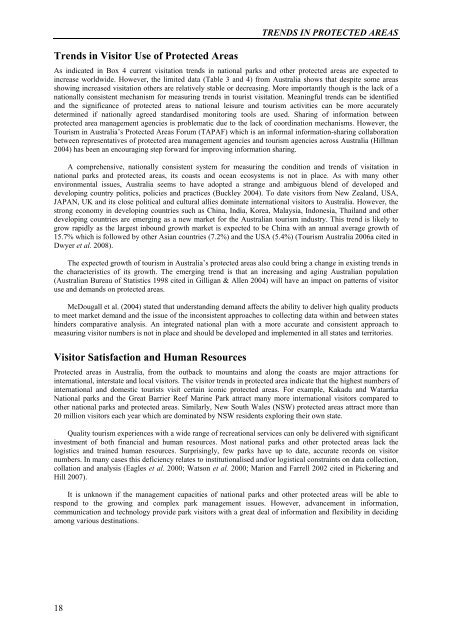TRENDS IN PROTECTED AREAS - Sustainable Tourism CRC
TRENDS IN PROTECTED AREAS - Sustainable Tourism CRC
TRENDS IN PROTECTED AREAS - Sustainable Tourism CRC
Create successful ePaper yourself
Turn your PDF publications into a flip-book with our unique Google optimized e-Paper software.
Trends<br />
in Visitor Use of Protected Areas<br />
18<br />
<strong>TRENDS</strong> <strong>IN</strong> <strong>PROTECTED</strong> <strong>AREAS</strong><br />
As indicated in Box 4 current visitation trends in national parks<br />
and other protected areas are expected to<br />
increase worldwide. However, the limited data (Table 3 and 4) from Australia shows that despite some areas<br />
showing increased visitation others are relatively stable or decreasing. More importantly though is the lack of a<br />
nationally consistent mechanism for measuring trends in tourist visitation. Meaningful trends can be identified<br />
and the significance of protected areas to national leisure and tourism activities can be more accurately<br />
determined if nationally agreed standardised monitoring tools are used. Sharing of information between<br />
protected area management agencies is problematic due to the lack of coordination mechanisms. However, the<br />
<strong>Tourism</strong> in Australia’s Protected Areas Forum (TAPAF) which is an informal information-sharing collaboration<br />
between representatives of protected area management agencies and tourism agencies across Australia (Hillman<br />
2004) has been an encouraging step forward for improving information sharing.<br />
A comprehensive, nationally consistent system for measuring the condition and trends of visitation in<br />
national parks and protected areas, its coasts and ocean ecosystems is not in place. As with many other<br />
environmental<br />
issues, Australia seems to have adopted a strange and ambiguous blend of developed and<br />
developing country politics, policies and practices (Buckley 2004). To date visitors from New Zealand, USA,<br />
JAPAN, UK and its close political and cultural allies dominate international visitors to Australia. However, the<br />
strong economy in developing countries such as China, India, Korea, Malaysia, Indonesia, Thailand and other<br />
developing countries are emerging as a new market for the Australian tourism industry. This trend is likely to<br />
grow rapidly as the largest inbound growth market is expected to be China with an annual average growth of<br />
15.7% which is followed by other Asian countries (7.2%) and the USA (5.4%) (<strong>Tourism</strong> Australia 2006a cited in<br />
Dwyer et al. 2008).<br />
The expected growth of tourism in Australia’s protected areas also could bring a change in existing trends in<br />
the characteristics of its growth.<br />
The emerging trend is that an increasing and aging Australian population<br />
(Australian<br />
Bureau of Statistics 1998 cited in Gilligan & Allen 2004) will have an impact on patterns of visitor<br />
use and demands on protected areas.<br />
McDougall et al. (2004) stated that understanding demand affects the ability to deliver high quality products<br />
to meet market demand and the issue of the inconsistent approaches to collecting data within and between states<br />
hinders<br />
comparative analysis. An integrated national plan with a more accurate and consistent approach to<br />
measuring visitor numbers is not in place and should be developed and implemented in all states and territories.<br />
Visitor Satisfaction and Human Resources<br />
Protected areas in Australia, from the outback to mountains and along the coasts are major attractions for<br />
international, interstate and local visitors. The visitor trends in protected<br />
area indicate that the highest numbers of<br />
international and domestic tourists visit certain iconic protected areas. For example, Kakadu and Watarrka<br />
National parks and the Great Barrier Reef Marine Park attract many more international visitors compared to<br />
other national parks and protected areas. Similarly, New South Wales (NSW) protected areas attract more than<br />
20 million visitors each year which are dominated by NSW residents exploring their own state.<br />
Quality tourism experiences with a wide range of recreational services can only be delivered with significant<br />
investment of both financial and human resources. Most national parks and other protected<br />
areas lack the<br />
logistics<br />
and trained human resources. Surprisingly, few parks have up to date, accurate records on visitor<br />
numbers. In many cases this deficiency relates to institutionalised and/or logistical constraints on data collection,<br />
collation and analysis (Eagles et al. 2000; Watson et al. 2000; Marion and Farrell 2002 cited in Pickering and<br />
Hill 2007).<br />
It is unknown if the management capacities of national parks and other protected areas will be able to<br />
respond to the growing and complex park management issues. However, advancement in information,<br />
communication<br />
and technology provide park visitors with a great deal of information and flexibility in deciding<br />
among various destinations.











